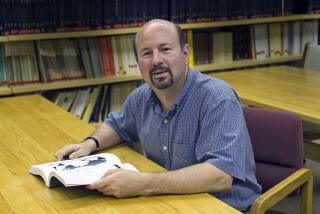John Maddox dies at 83; editor transformed Nature into influential journal
John Maddox, a former physics lecturer and science journalist whose 22 years as editor of Nature transformed the moss-covered journal into one of the world’s leading sources of science information, has died. He was 83.
Maddox died April 12 in Abergavenny, Wales, of a chest infection and pneumonia after a bout with a broken hip.
“His impact on the journal from the moment of his arrival in 1966 was more invigorating and far-reaching than anything that had happened to it since the time of its founding editor, Norman Lockyer,” said molecular biophysicist Walter Gratzer of King’s College, London, who often wrote for the journal.
“He was a polymath of knowledge about broad reaches of science and science policy,” said Bruce Alberts, editor of Nature’s long-time competitor Science. “He had wonderful effects on [Nature] as an agent for change.”
Maddox was an ardent campaigner against what he viewed as slipshod or misguided science, attacking London’s Sunday Times for its stance that AIDS was not caused by the human immunodeficiency virus, or HIV, and organizing an investigative team to demolish a French scientist’s claim for the efficacy of homeopathy. He ferociously denounced British biologist Rupert Sheldrake’s 1981 book, “A New Science of Life,” which contended that shapes and behavior in nature were caused by “morphic resonance” rather than DNA, calling it “a book for burning.”
Founded in 1869, Nature is one of the oldest scientific journals still around and one of the few to publish papers across the full range of scientific disciplines. Landmark papers in its history include the discovery of X-rays, the discovery of the neutron, the wave nature of elementary particles, the discovery of nuclear fission and the first description of the structure of DNA.
But when Maddox -- known to his colleagues as “JM” -- was recruited as editor in 1966, the journal had fallen on hard times.
Most of the papers it published were pedestrian, its News and Views section mostly ran official notices about birthdays and retirements, and a massive pile of submitted manuscripts had built up, many of them yellowing with age. The staff was small and overworked.
Maddox began recruiting a staff of intelligent young people, giving them unprecedented responsibility.
A formal reviewing system for manuscripts was established to replace the existing one in which papers were distributed to the editor’s cronies.
A style manual was created and submissions were extensively -- some said savagely -- copy edited to improve their cogency and readability.
Even as the editors worked their way through the accumulated manuscripts, Maddox was soliciting more, particularly those embodying high-quality, breakthrough research.
In the past, it had been customary for writers to publish preliminary results in Nature, “with the real meat to follow in a weightier organ,” according to Gratzer.
Under Maddox, Nature became the weightier publication and a highly desirable showcase -- along with its American competitor Science.
One often rejected physicist grew so desperate that he threatened to incinerate himself on Maddox’s doorstep if not published.
He eventually changed his mind after he discovered the ruse of running his paper as a paid advertisement.
Maddox also dramatically altered News and Views, replacing the shopworn announcements and birthday greetings with hard science news written by a team of accomplished science writers.
He made arrangements with the Times of London to have some of his staff’s work published daily in its pages, and he reached out to journalists around the globe with a timely tip sheet highlighting forthcoming papers, an effort that has made the journal a near-household name.
Recognizing the increasingly global nature of science, he established the journal’s first overseas office in Washington, following it up with others in New York, Tokyo and elsewhere.
As the volume of submissions grew, so too did the rate of rejections. To ease the problem, Maddox in the early 1970s started a pair of sister journals, Nature New Biology and Nature Physical Science.
That effort proved overly ambitious, and the new journals were killed off after he left the journal in 1973.
After he returned in 1980, however, he reestablished them, and Nature now publishes about 20 weekly and monthly journals.
In 1988, Maddox created his most famous controversy by agreeing to publish a paper by French scientist Jacques Benveniste showing that a highly diluted solution of antibodies -- so dilute that there were actually no antibodies left in it -- could be used to detect allergies.
But he agreed to publish the homeopathy paper only if he could send a team to Benveniste’s laboratory to examine his procedures.
Maddox, scientific fraud investigator Walter Stewart of the National Institutes of Health and magician James (the Amazing) Randi, who specializes in exposing scientific charlatans, visited the French lab and concluded that Benveniste’s findings were the result of “shoddy science” and the researchers’ own “delusions.”
Many viewed it as an attack on the French in general and as an unwarranted intrusion into the laboratory, but the episode had the effect of quelling research into the area.
John Royden Maddox was born Nov. 27, 1925, in Penllergaer, Swansea, Wales, son of a furnaceman at an aluminum plant.
He received a bachelor’s degree in chemistry from Oxford University in 1947 and a graduate degree in physics from the same school in 1952, and lectured in theoretical physics for six years at the University of Manchester.
In 1955, he became a science writer for the Manchester Guardian, one of the first people to assume such a role. From 1964 to 1966, he was director of the Nuffield Science Teaching Project, which looked for better ways to teach science.
Between his terms as editor of Nature, he started his own environmental magazine, which failed, and was a director of the Nuffield Foundation.
On his retirement from Nature in 1995, he was knighted. Five years later, he was named the first honorary member of the Royal Society.
Maddox wrote several books, including one on the energy crisis, one on nuclear proliferation, and his most famous: “What Remains to Be Discovered,” a comprehensive tour of unanswered scientific questions.
Maddox’s first wife, the former Nancy Fanning, died in 1960. He is survived by his second wife, journalist and biographer Brenda Murphy Maddox; two sons, Bruno of New York and Piers of Totnes, Devonshire; two daughters, Bronwen and Imma, both of London; a brother, Don, of Letton, Herefordshire; and two grandchildren.
More to Read
Start your day right
Sign up for Essential California for news, features and recommendations from the L.A. Times and beyond in your inbox six days a week.
You may occasionally receive promotional content from the Los Angeles Times.






